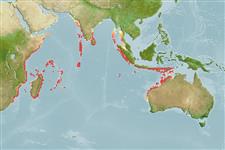Actinopterygii (ray-finned fishes) >
Perciformes (Perch-likes) >
Chaetodontidae (Butterflyfishes)
Etymology: Chaetodon: Greek, chaite = hair + Greek, odous = teeth (Ref. 45335). More on author: Bennett.
Environment / Climate / Range
Ecology
Marine; reef-associated; depth range 3 - 30 m (Ref. 90102). Tropical, preferred ?; - 30°S
Indian Ocean: Red Sea south to Durban, South Africa (Ref. 5372) and east to Christmas Island. Reported from western Thailand (Ref. 9710) and Bali, Indonesia (Ref. 8631).
Size / Weight / Age
Maturity: Lm ? range ? - ? cm
Max length : 12.0 cm TL male/unsexed; (Ref. 5372)
Inhabit lagoon and seaward reefs (Ref. 9710). Occur in pairs or small groups (Ref. 9710, 48636). Feed on polychaetes, coral polyps, and algae (Ref. 9710). Oviparous (Ref. 205). Form pairs during breeding (Ref. 205).
Life cycle and mating behavior
Maturity | Reproduction | Spawning | Eggs | Fecundity | Larvae
Form pairs during breeding (Ref. 205).
Heemstra, P.C., 1986. Chaetodontidae. p. 627-632. In M.M. Smith and P.C. Heemstra (eds.) Smiths' sea fishes. Springer-Verlag, Berlin. (Ref. 5372)
IUCN Red List Status (Ref. 115185)
CITES (Ref. 94142)
Not Evaluated
Threat to humans
Harmless
Human uses
Aquarium: commercial
More information
ReferencesAquacultureAquaculture profileStrainsGeneticsAllele frequenciesHeritabilityDiseasesProcessingMass conversion
Tools
Special reports
Download XML
Internet sources
Estimates of some properties based on models
Phylogenetic diversity index (Ref.
82805): PD
50 = 0.5000 [Uniqueness, from 0.5 = low to 2.0 = high].
Bayesian length-weight: a=0.02291 (0.01138 - 0.04611), b=3.01 (2.84 - 3.18), in cm Total Length, based on LWR estimates for this Genus-body shape (Ref.
93245).
Trophic Level (Ref.
69278): 3.1 ±0.33 se; Based on food items.
Resilience (Ref.
69278): High, minimum population doubling time less than 15 months (Preliminary K or Fecundity.).
Vulnerability (Ref.
59153): Low vulnerability (10 of 100) .
